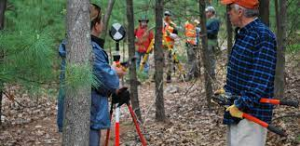History is written in blood and almost every conflict throughout time has been inadequately documented, creating mysteries and gray areas in battles that forged nations. A specific sub-area of archaeology, battlefield archaeology, studies the material remains of these conflicts in order to evoke a greater understanding of the violence and strategy of these historic battles.
Troop formations, military tactics, and the exact positions soldiers were standing can be determined by the martial debris left behind: buttons, coats, straps, shrapnel, etc. (American Battlefield Trust 2021). The concentration of martial debris is equally important as well, where a higher concentration of artifacts in a specific area can better track movement and positions on the battlefield. These artifacts are carefully excavated, flagged, and categorized in order to map out the battle. Furthermore, the location of these artifacts is often more important than the artifact itself because it helps archaeologists visualize the entirety of the battle in the surrounding area.

Archaeologists excavate and flag the locations of artifacts using cameras and photo scales at Minute Man National Historical Park (American Battlefield Trust 2021).
Military data and records have been a historical gray area for years, as militaries rarely recorded detailed information and after-action reports in previous centuries. More specifically, many aspects of battles throughout American history have remained mysteries, as records have been few and far between. One of the most important conflicts in American history, the Revolutionary War, had many sporadic and scattered skirmishes, and accurately dating and identifying these battles has been difficult for historians. With the help of battlefield archaeology, historians have been able to paint a clearer picture of the movement, positions, and artillery formation of these battles that define vital moments of American history.
One battle of the Revolutionary War, Parker’s Revenge, in which Captain John Parker rallied his troops in Lexington and Concord after the “shot heard round the world” has recently been brought to light after ten musket balls and a cluster of other artifacts were uncovered by battlefield archaeologists (American Battlefield Trust 2021). The shape and disfigurement of these musket balls accurately show the troop formation in which they were shot, the target they were aimed at, and the firing range of the muskets (Zorich 2022). Battlefield archaeologists were able to conclude which musket balls hit soldiers, missed, or were mistakenly dropped on the ground, allowing them to map out specific locations of the battle, and how these soldiers moved in reaction to the environment and conflict itself.

Archaeologists flagging and excavating artifacts found on the site of Parker’s Revenge in Minute Man National Historical Park (Archaeology 2016).
Battlefield archaeology brings gray areas of history to light, solving mysteries of past battles. Visualizing the movement, positions, and actions of these soldiers as they fought for their lives depicts the bravery, sacrifice, and violence of the history of each nation. Battlefield archaeology reveals the untold stories of past conflicts and provides an in-depth comprehension of important moments of history.
Additional Content for Further Discovery
References
American Battlefield Trust. “Archaeology Pinpoints Site of Parker’s Revenge near Lexington.” American Battlefield Trust. American Battlefield Trust, March 25, 2021. https://www.battlefields.org/learn/articles/archaeology-pinpoints-site-parkers-revenge-near-lexington.
American Battlefield Trust. “The Importance of Battlefield Archaeology.” American Battlefield Trust. American Battlefield Trust, March 25, 2021. https://www.battlefields.org/learn/articles/importance-battlefield-archaeology.
Carman, John. “Battlefield Archaeology.” SpringerLink. Springer New York, January 1, 1970. https://link.springer.com/referenceworkentry/10.1007/978-1-4419-0465-2_1330.
National Parks Service. “Archeology at Antietam (U.S. National Park Service).” National Parks Service. U.S. Department of the Interior, April 16, 2020. https://www.nps.gov/articles/archeology-at-antietam.htm.
Urbanus, Jason. “Finding Parker’s Revenge.” Archaeology Magazine. Archaeological Institute of America, 2016. https://www.archaeology.org/issues/202-1601/trenches/3933-trenches-massachusetts-revolutionary-war-parker-s-revenge.
Zorich, Zach. “A Battlefield from 1777 Yields a Dozen Mercenaries’ Remains.” The New York Times. The New York Times, August 3, 2022. https://www.nytimes.com/2022/08/02/science/archaeology-revolutionary-war-red-bank.html.

What might battlefield archaeology help us understand about other (i.e. civilian) components of a culture in a given time and place?
Battlefield archaeology can be a crucial component in gaining insight to civilian life. After all, most soldiers were inexperienced young men. Letters and diaries to loved ones are vital artifacts that can be recovered from battle sites, camp sites, and homes across the nation. These artifacts can help archaeologists understand the daily life of these young men and what they were accustomed to. Their struggles with adjusting to military life and their emotions are documented as well. Battlefield archaeology is another aspect of archaeology that deepens our comprehension of people and the lives that they lived.